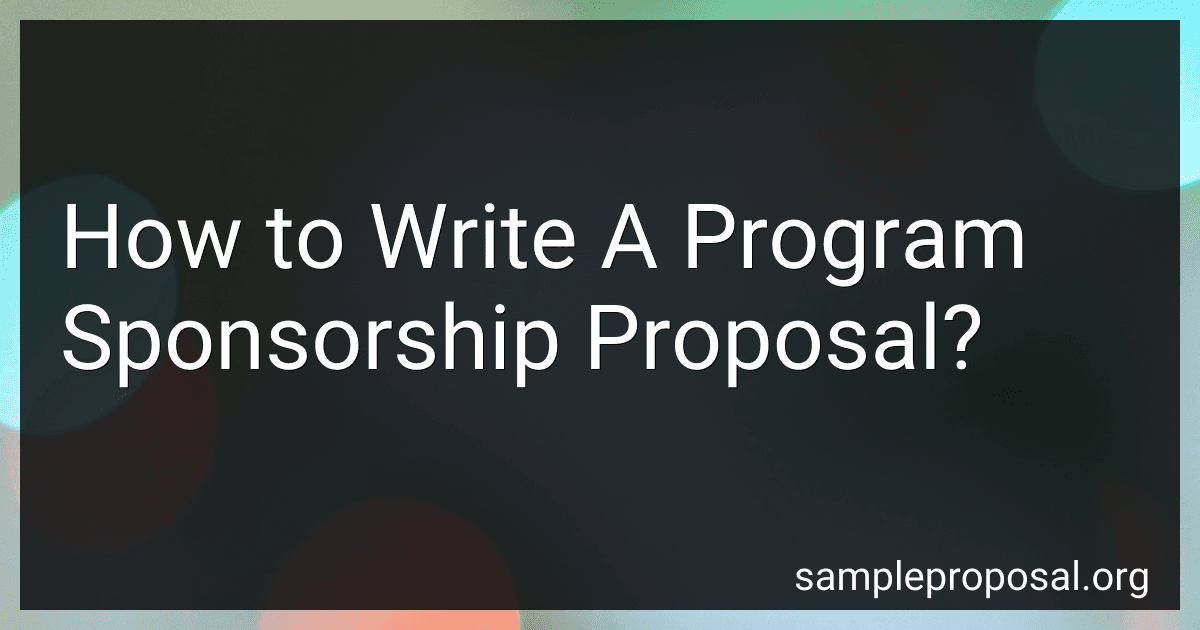Best Sponsorship Proposal Guides to Buy in December 2025
When writing a program sponsorship proposal, it is important to start by introducing your organization and the program you are seeking sponsorship for. Provide a brief overview of the program, its objectives, target audience, and any previous success or impact it has had.
Next, clearly outline the benefits and value of sponsoring your program. This could include brand exposure, access to a specific demographic, networking opportunities, and the chance to align with a cause or mission that resonates with the sponsor's values.
Include a detailed budget and list of specific sponsorship packages or opportunities, outlining what each level of sponsorship includes and the associated costs. Be sure to clearly communicate the return on investment for sponsors and the potential reach and impact of the program.
Finally, make sure to personalize your proposal for each potential sponsor, demonstrating that you have done your research and understand how their brand or values align with your program. End your proposal with a call to action, inviting the potential sponsor to discuss further or provide any additional information they may need.
How to create a compelling call to action in your program sponsorship proposal?
- Clearly state the benefits: Highlight the specific benefits and value that the sponsor will gain from partnering with your program. This could include increased brand visibility, access to a targeted audience, networking opportunities, or the chance to showcase their products or services.
- Use persuasive language: Use strong, action-oriented language to encourage the sponsor to take action. For example, phrases like "Join us in reaching a community of passionate followers" or "Don't miss this opportunity to elevate your brand to a new level" can create a sense of urgency and excitement.
- Make it easy to respond: Provide clear instructions on how the sponsor can get involved, whether it's through contacting a specific person, filling out a form, or visiting a website. Make it as easy as possible for them to take the next step.
- Create a sense of exclusivity: Emphasize that sponsorship opportunities are limited and that partnering with your program will give the sponsor access to a unique and desirable audience. This can make the opportunity more enticing and increase the sponsor's motivation to act quickly.
- Include a compelling incentive: Offer a special incentive or bonus for sponsors who commit to the partnership, such as extra promotion or exclusive access to events. This can encourage sponsors to take immediate action and strengthen their commitment to the partnership.
Overall, a compelling call to action in your program sponsorship proposal should clearly outline the benefits of partnering with your program, use persuasive language to encourage action, make it easy for sponsors to respond, create a sense of exclusivity, and offer a compelling incentive to seal the deal.
What are the key statistics to include in a program sponsorship proposal?
- Demographic information about the target audience (age, gender, income level, etc.)
- Audience reach and engagement metrics (estimated number of attendees, social media followers, website traffic, etc.)
- Previous event or program performance data (attendance, satisfaction surveys, return on investment, etc.)
- Sponsorship benefits and opportunities (logo placement, brand mentions, speaking opportunities, networking events, etc.)
- Budget breakdown and sponsorship package options (title sponsor, presenting sponsor, supporting sponsor, etc.)
- Success stories and testimonials from previous sponsors
- Contact information for further discussion and negotiation.
What are the key components of a successful program sponsorship proposal?
- Introduction: Provide a brief overview of your organization, its mission, and the event or program that is seeking sponsorship.
- Objectives: Clearly outline the goals and objectives of the event or program, as well as the specific outcomes you hope to achieve with the sponsorship.
- Target audience: Describe the demographics and characteristics of the audience that will be reached through the event or program, explaining why they are valuable to potential sponsors.
- Sponsorship benefits: Clearly outline the benefits that sponsors will receive in return for their support, such as brand visibility, audience engagement, and networking opportunities.
- Sponsorship packages: Offer a range of sponsorship packages with varying levels of benefits and opportunities for sponsors to customize their involvement.
- Budget and costs: Provide a detailed breakdown of the budget for the event or program, including the cost of sponsorship packages and a clear explanation of how the funds will be used.
- Marketing and promotion plan: Detail the marketing and promotion strategies that will be used to promote the event or program, as well as how sponsors will be included in these efforts.
- Recognition and visibility: Explain how sponsors will be recognized and acknowledged throughout the event or program, both on-site and in promotional materials.
- Evaluation and reporting: Outline how the success of the sponsorship will be evaluated and measured, as well as how sponsors will be provided with a report on the impact of their support.
- Call to action: Encourage potential sponsors to take action by providing clear instructions on how to get involved and highlighting the benefits of supporting your organization or event.
What is the response rate for program sponsorship proposals?
The response rate for program sponsorship proposals can vary greatly depending on various factors such as the target audience, the industry, the content of the proposal, and the level of competition in the market. However, it is common to see response rates ranging from 10% to 30% for program sponsorship proposals. It is important for organizations to carefully research and target potential sponsors, tailor their proposals to the specific needs and interests of each sponsor, and follow up promptly to increase their chances of securing sponsorship.
